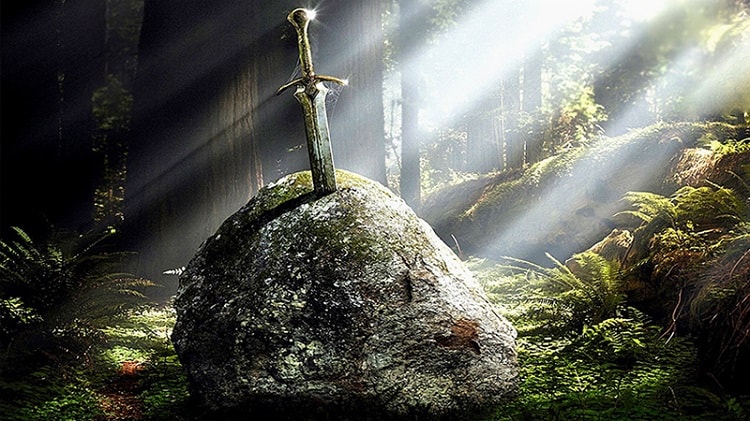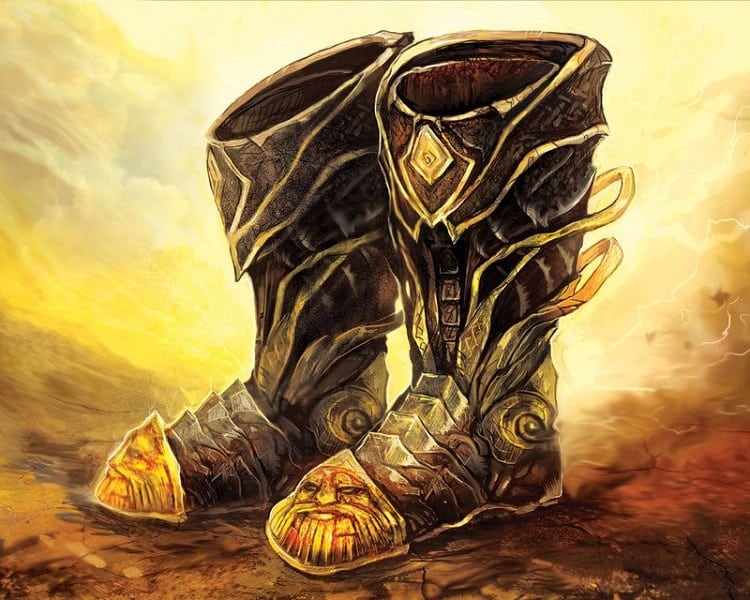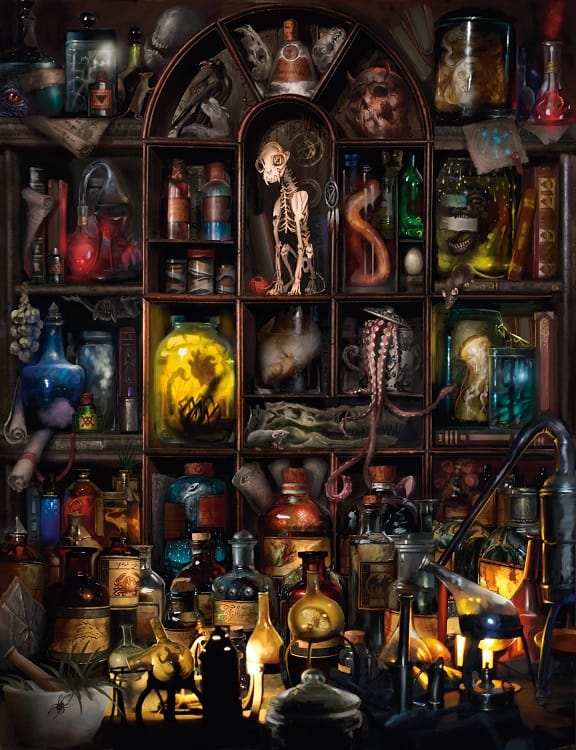The world of Faerun is a magical place, where monsters, magic, and evil all are in abundance. Stories and legends are told in this world, and part of those legends include magical weapons and items.
There are hundreds of magical weapons and armor pieces, not to mention rings, pieces of clothing, and other traditional items that just happen to be magically touched.
However, even with all of these official pieces of content, for some players and DMs, it is not enough and they need more! That’s where homebrewed magical items come in, and it brings the number of available magical items way up!
But how do you incorporate your homebrewed magical items into the game? What makes them so interesting, and how do you give them to your players? If you are asking these questions, then guide to 5e Homebrew Magic Items Ideas is for you.
Is Your World High Magic or Low Magic?
Before you delve into creating several magical items for your campaign, consider what type of campaign you would like to run. Do you want to do one where magical items are available in every single store, found in various dungeons, and on everyone from the lowliest guard to the king? If so, that’s a high magic world.
But if you have a world where only the best of the best weapons get magical weapons, where the ancient weapons of this world are buried with the heroes that won them, and the best weapons need to be ripped from the cold dead hands of their previous owners, then you have a low magic world.
Of course, you could pick a medium magic world where magic items are found in some shops for high prices and given as rewards for quests. Still, you need to pick which world your campaign will land in, as this will show how your homebrewed magical items can get into the hands of your players.
Related reads: D&D Homebrew Weapon Ideas, D&D Homebrew Explained
What is the Story Behind Your Magical Item?

Excalibur, the One Ring of Power, the Invisibility Cloak, the Spear of Destiny, and the Bow of Robin Hood. All of these items have legends attached to them, and those legends are part of what gives them their power. The magical items in your world are no different, as they should have stories.
They don’t need to be massive, but you should at least think of a few lines to describe the purpose of the magical item in your world and how it was used.
For example, the magical mace held by the warrior queen might have been used to slay the foul orc chief, shattering the horde and their previous invasion of the kingdom. The mystical jar that always produces alchemical ingredients might have been created for a special alchemist who always seemed to forget his tinctures and ingredients.
These little stories don’t just provide lore for your world, but also a good reason for why the items have the effects that they do. It’s a good way to brainstorm.
How to Keep Magical Items Balanced
Since there is an infinite number of magical items with an infinite number of possible benefits, you should be wondering how to make sure your remains balanced with everything your world has to offer.
First, look at other magical items for examples of what to do correctly. If you want to create a magical weapon, then explore the rabbit hole of magical weapons for D&D, and the same goes for any other wondrous items.
You can also simply reskin a magical item from another system, such as Pathfinder or an older edition of D&D. For example, a useful Pathfinder item is the Ioun Torch, which states:
This item is burned out, dull gray ioun stone with a continual flame spell cast upon it. It retains the ability to float and orbit, and allows the bearer to carry light and still have his hands free. It may be in any crystalline shape common to ioun stones (ellipsoid, prism, sphere, and so on).
Ioun stones are in both 5e and Pathfinder, so you could give your players an Ioun Torch if they are going into a lot of darker areas, and also explain the lore of the stones so your players can find the D&D versions.
You can also focus on giving your magical items requirements. For example, your players might have to tune to them (giving them a hard choice to make if they’ve filled their three attunement slots), or they might need to be a certain race or alignment to use the item effectively.
Read also: The Best Homebrew Spell Ideas.
Make Sure Your Players Can Use Them

Finally, one of the biggest problems is that a lot of magical items are introduced that players just won’t use. It’s not a matter of ‘This magical sword is better than this magical axe, so I’ll use the sword.’ However, it’s more of an item that is really out of place in the environment of the campaign.
For example, if you have ‘Boots of Lava Walking’ that give your players the ability to walk on lava with no harm, as well as fire resistance, you need to make sure they can be used. If your party doesn’t have a chance to actually walk on lava and battle enemies that use fire attacks, then those boots get tossed into the sell pile.
Read here to find out How Lava Works
Attach a Quest to Them
Another way to make your homebrew items stand out whenever it comes to a high magic world is to attach a quest to them. For the magical mace that was wielded by a queen to stop that orc invasion, maybe the orcs are coming back and the queen is long dead.
So the party needs to travel to her tomb and prove they are worthy of the mace. Then they need to reforge the old weapon into something that can be used in combat.
Finally, they need to restore the weapon’s legend by battling orc raiding parties with it, creating fear in the orc horde and potentially stopping the invasion before it can begin.
That’s certainly more interesting than simply finding the weapon in a chest and forgetting about it. If you give the characters something to work with, then they will become more attached and will use the weapon with pride.
Not All Magical Items are Created Equal

We’ll take a page from the Dwarf Fortress video game for this next bit. In the game, dwarves can enter strange moods, creating legendary items that can increase the wealth of your fortress and can also be used or worn. Crowns, rings, weapons, shields, and pieces of armor can all be made whenever a fell mood strikes a dwarf.
However, it’s just as likely that your Dwarf will create an artifact barrel, door, manhole cover, or sock. They might sell for a lot and look pretty, but they aren’t the most useful. Your magical items can be the same way in D&D, just window decoration and not much else.
You can have legendary smiths forge weapons that could slay gods, armor that can stand a thousand arrows, and rings that allow anyone to tap into the powers of the arcane. Then there’s whatever one wizard created when he grabbed the first thing he saw and slapped a spell on it. It happens with products in the real world, so why not in 5e?
Don’t be afraid to be funny with magical items, because for every good one there are probably a few dozen not-so-good ones out there. You might have swords and armor that are as durable as steel but made of candy and they produce sparkles when licked.
You could have a bow that shoots arrows tipped with pies that always strike your enemy in the face. You could even have a ring that bewitches a target for 10 minutes into thinking they are a sheep.
Now, if you aren’t playing a comical or silly game then you don’t want to overdo it. But even in the most grimdark and serious RPs, a little levity can be appreciated. Plus, some of the sillier magical items can still be used effectively in the hands of serious players.
It’s always amazing when those sillier weapons get to be the ones that take on the boss or get the party out of a sticky situation. It does happen and those are the moments that get talked about the most whenever the session is over.
Look at Your Players
If you want to make sure that your players are going to use the magical items, take a few sessions and look at how they play. If you have a druid that loves commanding animals to fight for them, maybe give him a staff that allows him to control a swarm of small woodland creatures once per day.
If your bard loves plucking on a fight during downtime, give her a magical fight that buffs her allies for the next combat. Your players will show you what kind of magical items they would use, and they might even allude to one in their backstory that you can bring in later.
For example, your Paladin could have joined the party looking to find a magical hammer that belonged to his order. You could easily have a quest where your paladin finds his magical weapon and then needs to attune it again to get it’s full effects..
5e Homebrew Magic Items FAQs
Question: How Do I Make Sure they are not Overpowered?
Answer: The best way to do this is to talk to your players and maybe even other DMs. If they’ve been playing longer than you’ve been DMing, then listen to them. You might need to place certain restrictions on when the weapon can be used or lower its abilities.
Generally, if you are looking out for an overpowered item there’s a good chance it won’t be overpowered… but still, keep it in mind.
A little conversation goes a long way when it comes to homebrewed items, so make sure to talk it out. Your players might even have some input of their own when it comes to adding magical items into the world.
Finally, if you are really concerned with power levels, then you should find a similar item from D&D or another game and simply reskin it. Change a few numbers and names around and add some abilities and you’ll be fine. It will fit into the game without fail.
Question: How Do I Give them to my Players?
Answer: In most cases, the item’s backstory will help you figure out whether the item is part of a quest or just able to be found or bought.
A magical set of armor belonging to a still living king might be a reward for a quest or given from the royal armory as a reward. While a magical ring that lets you levitate for 10 minutes could be sold at most local magical shops.
You should also assign a rarity to your items, with rare items being the focus of quests and larger objectives, and common items found in chests and at storefronts. Again, your players might have backstories with magical weapons of their own, and you can easily weave those into your story.
Question: Do I Tell my Players These Items are Homebrew?
Answer: That depends. If you are making a weapon or a set of armor specifically for a player, then you probably want to tell them and bring them into the loop. If a player asks about the magical item, then you can share.
Otherwise, it’s a bit more fun to make something mesh into the world so seamlessly that the players at your table think that it is real content.
You’ll know when to spill the beans, but you’ll also know when to keep quiet. After all, the difference between a good DM and a great DM is that you don’t know where the Great DM’s stuff came from!
- DnD Demons Guide: What Are Demons in 5e? - September 18, 2021
- Detect Thoughts 5e Guide: When, Why and How to Use It - September 9, 2021
- The Ultimate DnD Toll the Dead 5e Guide - September 9, 2021

